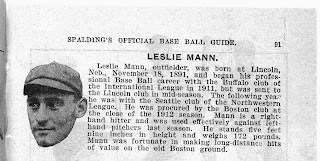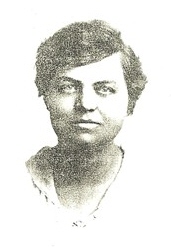William Cooper > Amos Cooper > Chalkley Jared Cooper, Sr > Joseph L Cooper >
Jessie Cooper
 |
| Young Les Mann |
and Leslie Mann
The great extended Cooper clan of Pennsylvania was everywhere in the Stephenson/Winnebago counties area by the late 1800s. Amos, the first pioneer, who had settled in Clark County, Illinois had a large family which included Chalkley Jared Cooper and his wife Margaret Ann Thompson who had found roots in Stephenson County. They were successful and very well-regarded citizens of Rock Grove.They had nine children, the fourth being Joseph L Cooper, who headed west to Nebraska.
Joseph married his wife, Carrie Miles, born in Marengo, Iowa, on 26 Dec 1881 in Buffalo, Nebraska. He lived in Norfolk, and was later a day laborer in Lincoln and eventually ended up in Omaha, owning a second-hand shop. They had three children: Fred Harmon, who died at age 30 in 1914, Jennie, and Jessie. Jennie is not listed as a surviving child in her parents' obituaries, so I would guess she too died young.
Jessie met Leslie Mann, a star 4-letter man who attended Lincoln High in Lincoln, and married him immediately after his graduation, on 04 Mar 1911 across the river from Omaha in Council Bluffs, Iowa. Leslie was the son of Samuel and Minnie Mann of Lincoln. Leslie and his brother Chauncey (Channing) R Mann, both stood out on the athletic field. Both would make athletics/education/service their life's calling. Les looked back later in life on his greatest sports moment and he said it was the football game between Lincoln High and Omaha Central in 1909 or 1910. Football would remain the game he loved best.
 |
| Miracle Braves of 1914 |
Leslie attended Springfield YMCA college in Springfield, Mass, where he also 4-lettered. In 1913, he joined the Boston Braves and played in the World Series as an outfielder on the "Miracle Braves of 1914." The team had moved from dead last in the rankings in the last two months of the year and ended up taking it all in four games straight (you can read more about that
here).
 |
| Les Mann as a Cub |
In 1915, he moved on to play with the Chicago Cubs and played in the 1918 World Series between the Cubs and Boston Red Sox. It was while in Chicago that their only child, Leslie Mann, Jr., was born in 1918. Mann would have an RBI single off of the famous Babe Ruth in Game 4 of the 1918 World Series. He would later also play for the St Louis Cardinals, Cincinnati Reds, and New York Giants.
Baseball wasn't the million dollar contract game then that it is now, so Les coached between seasons. He taught basketball at Amherst from 1915-1917, and Phys Ed at Rice Institute from 1919-1924. During the first World War, he worked at Camp Logan in Texas for two years. He was the head basketball coach for Indiana University in the 1922-23 and 1923-24 seasons and at Springfield College in the 1924-25 and 1925-26 seasons.
Once he retired as a player and coach, Mann became an advocate for baseball as an international sport. He founded the USA Baseball Congress and organized a 20-game tour of Japan in 1935. He was also largely responsible for baseball being selected as a demonstration sport for the 1936 Olympics in Berlin. He went on to found the International Baseball Federation, which organized an international championship in England in 1938, Cuba in 1939, and Puerto Rico in 1941.
 |
| Spalding Official Base Ball Guide |
During World War II, he worked for the USO, first as director of the federal USO building in Tampa,
Florida, and later as director of the mobile division of the USO for the West Coast area.The family, after a life on the road, settled in the Pomona/Pasadena area of California and Les remained mostly retired after the War. Les wrote many books on various sports.
 |
| Coach Mann, Indiana University Basketball, 1922-23 |
Tragically, Leslie's California retirement was cut short. Despite his athletic background and good health, Les and Jessie were driving in Pasadena on 14 Jan 1962 when Les complained of feeling faint. Moments later, he had a massive heart attack, lost control of his vehicle, and hit two parked cars. Mrs. Mann survived the crash, but Les died of the heart attack that day at the age of 67. Jessie died 08 Jul 1969.
Jessie & Leslie's son Leslie grew up to serve in the US Navy during World War II as an Ensign. After the War, he attended Stanford Law School. He married and was a successful attorney in Pomona who later resided in Scottsdale, Arizona. They had a son, Leslie Mann III.





























